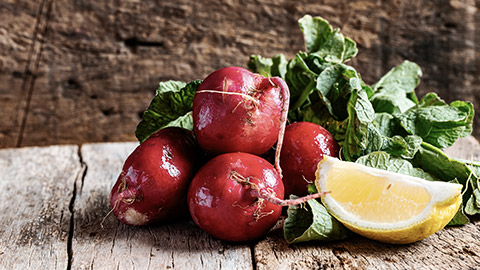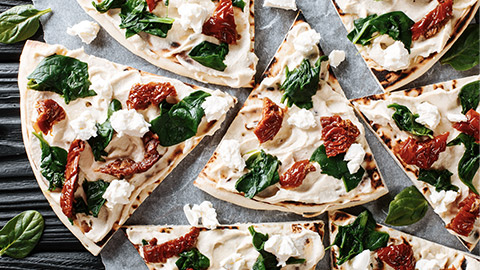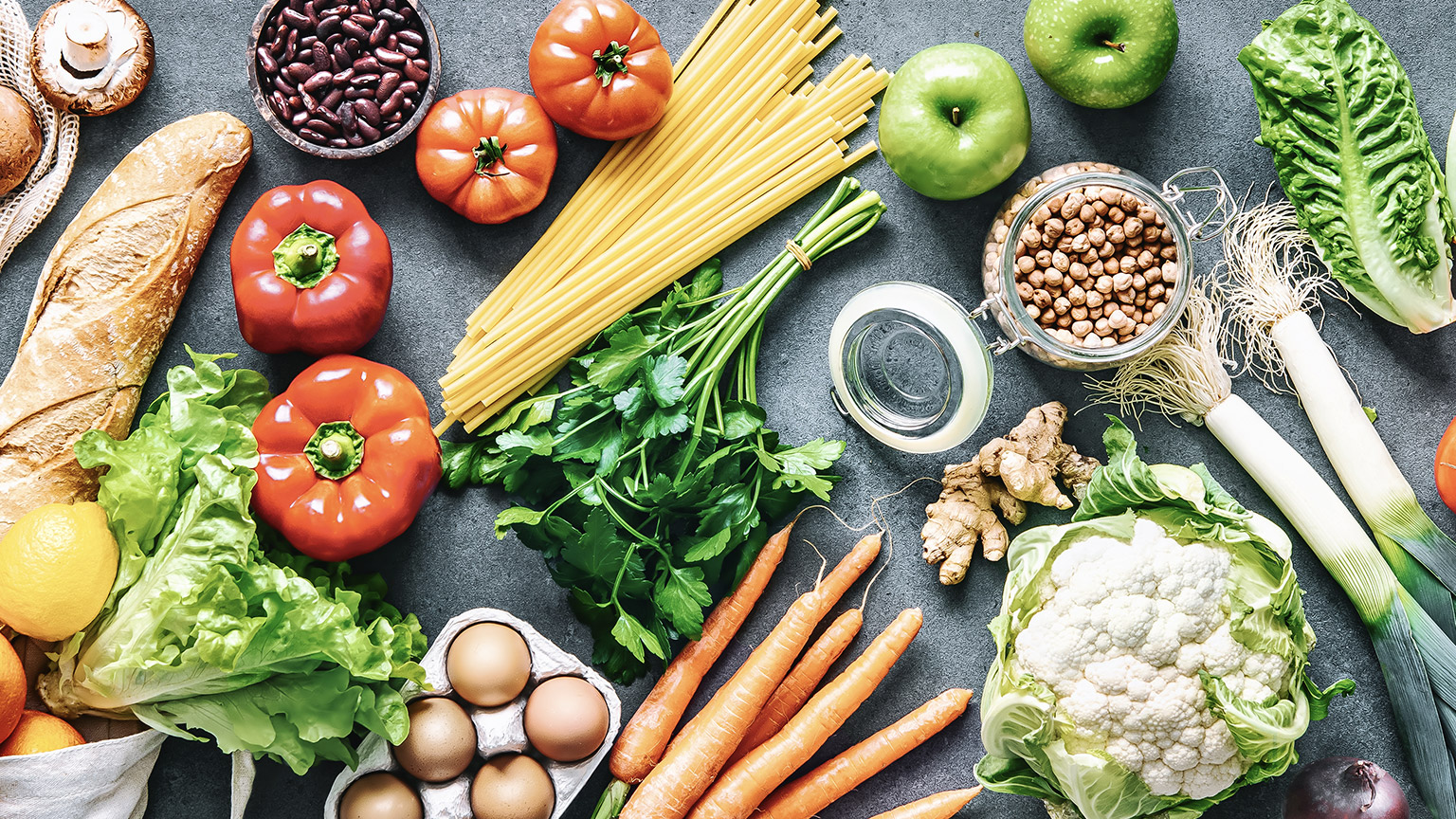Consumables are part of the everyday running of most commercial kitchens.

Kitchen consumables are items designed to be used briefly or temporarily and then discarded.
This category of products includes things such as:
- cling-film (plastic wrap)
- aluminium foil
- latex or vinyl gloves
- disposable piping bags
- prep containers
- hair nets
- plastic aprons
- baking paper.
All of these items have a benefit in running a commercial kitchen and are needed – they help keep food fresh and safe to eat, help retain heat in cooking, help maintain personal hygiene in food handling, allow good food storage and organisation etc. Their use is so widespread it is easy to forget that these products also have an impact – a cost to the business, as well as a cost to the environment.
Exercise 21
In your journals write detailed answers to the following questions:
- What do you think this slogan means?
- Is the order (Reduce→Reuse→Recycle) important? Why?
- How could the Reduce→Reuse →Recycle strategy work in a commercial kitchen? Give specific examples of where you could reduce, reuse and recycle.
Read this article, How to Minimize Food Waste in Commercial Kitchens, for some ideas and apply them to what you know from where you work or have worked in the past.
Self-Directed Learning
Task 1 - Complete your draft of 2 of the 4 topics and submit for Checkpoint 1.
(Remember Task 1 is all about the impact of the hospitality industry on resources -explain the problem but don’t offer solutions here.)

For the two key topics you chose to write about in Task 1, you now need to find practical ways in which a food business can improve sustainability in terms of food usage.
To do this, explain the suggested strategy, add appropriate examples, images, and data, and then analyse the advantages and disadvantages in terms of the:
- hospitality business itself
- customers
- environment and the world’s natural resources.
Over the next two sessions complete two research activities from the four below, matching the topics you wrote about in your assessment Task 1. Make notes and save any links to information, images, and data you will be able to use in your written assessment Task 2.
The Research Activities to choose from are:
Before jumping into the research activities:
1. Watch the short video about the Silo restaurant in London which has zero waste.
Watch
2. Now read this article, The Importance of Sustainability in the Hospitality Industry, which discusses some of the benefits of running a sustainable kitchen.
Research activity option 1: food waste
Begin by watching the short video clips which contain some basic concepts. Use these as a starting point for more in-depth research on a strategy you think would help a commercial food business to reduce the amount of food it wastes. You will need to dig deeper to find some real information about how the ideas work and how much it helps reduce food waste, and then analyse the advantages and disadvantages. Your key focus should be to Reduce, Reuse and Recycle.
Watch
Here is a list of other food waste links you may wish to check out:
- China launches 'Clean Plate' campaign against food waste
- KiwiHarvest, Feed More Waste Less Kai Atu
- Waste not, want not: The collective turning surplus food into bread and beer
- 13 Easy Ways to Create a Sustainable Restaurant Menu
- Wasting Food Feeds Climate Change
- Making biodiesel from cooking oil and agricultural waste just got easier
- The oil that cooked your fries will soon be refueling your aircraft
- Qantas trials cooking oil in biofuels flight
- Austin Restaurants Can’t Throw Away Food Waste Anymore
- Mitigation of food wastage, societal costs and benefits
- Follow the food episodes
- A Food Waste Solution
- Home Bio-Digesters: How to Convert Waste Into Cooking Fuel
- On Site Food Waste Solution
- 17 Ways to Reduce Food Waste in Your Restaurant
Research activity option 2: sustainable ingredient choices
What are your options to make more sustainable ingredient choices? This is another really important topic with several angles possible to improve choices made for the menu. You should concentrate on one or two key points which are focused on how a commercial food business can contribute to minimising waste and environmental sustainability.
Revisit the MPI Status of Fish Stocks from Lesson 7 and the NZ Forest and Bird Consumer Guide to Sustainably Caught Seafood.
Which commonly served fish species are the worst choices for sustainability?
Other links to help you research sustainable ingredients you may wish to check out:
- A neglected protein-rich 'superfood'
- Tora Collective - Coast to Plate
- The Shepherd Story
- The Shepherd Story: Tora Collective
- 'Slow fish' chef wants Kiwis to know who catches their seafood
- Skye Gyngell - Spring
- What Does Food Look Like When Sustainability Is The Main Ingredient?
- Green Tracker: How sustainable menus are evolving
- Heirloom - May Menu
- Coastal Style - Heirloom Natural Wine Dinner
- Responsible hospitality – watch your water use
- The National Restaurant Association's Conserve Program - Serving Up Sustainability
Research activity option 3: energy and water use
We have already seen that commercial hospitality is one of the most energy and water consuming businesses. How could you make your food business more environmentally responsible in its energy use and water consumption? Remember to focus on practical measures which are realistic and able to be implemented economically in a typical food business kitchen.
Look for ideas to reduce energy and conserve water in the kitchen. What practices are businesses currently adopting?
Other links to help you research energy and water conservation you may wish to check out:
Research activity option 4: packaging and consumables
The dilemma facing us with packaging is that there is a clear problem with plastic waste causing environmental degradation, yet our industry relies on the benefits of plastic to a large degree to keep food safe and fresh – and therefore help minimise food waste. So what can we do to be part of the solution of excess waste generation in packaging and the use of consumables in making and selling our product?
Again, find methods for a business to reduce, reuse, recycle packaging waste with particular emphasis on reduce. Your solutions should offer alternatives which maintain high levels of food safety and hygiene and do not lead to more food being wasted through spoilage. As before, ideas put forward should be practical and economically viable for a food business to implement.
Other links to help you research packaging and consumables you may wish to check out:
- How to reduce packaging waste in the catering industry
- Sustainability at Mexico
- Takeaway without the throwaway
- This zero-waste packaging is made from bamboo
- A Spoon You Can Eat Is a Tasty Alternative to Plastic Waste | Short Film Showcase
- Bioplastics rivals BASF and Novamont unveil compostable cling films in fundamental breakthroughs

As we have seen in previous deliveries, food businesses operate on tight margins – fresh ingredients are expensive to buy and have a very limited lifespan in which to be sold. We have also seen in Task 1 that food waste is a huge environmental problem for the whole planet.
Understanding these two key concepts and doing something about it in how we run a hospitality operation is vital not only from an environmental perspective, but a sound economic perspective too – minimising food waste is a great way to maximise profits.
Task 2 uses the knowledge we have gained about the impact that choices made running a food business have on the environment to find sensible, practical ways we can minimise the negative effects. Some of the techniques are common sense solutions that not only benefit the environment but also help make the food business more profitable and efficient.
There are many ways to be better organised with purchases and to better look after ingredients, but there are also some useful culinary techniques which can make the best use of the ingredients we have purchased and to preserve them to give them a much longer useable lifespan.

Food Preservation
Preserving food means transforming it through various methods to make it safe to use for a much longer period of time. Making food safe involves killing the micro-organisms which cause spoilage and creating a sterile environment in which to store the food. Food preservation has been practiced for hundreds of years in some form – for example honey was used to preserve quince in ancient Greece and Rome. (National centre for home preservation, 2002);
Some common methods of food preservation are:
- dehydrating
- freezing
- canning or bottling
- salting
- pickling
- sugar
- vacuum packing
- smoking
Exercise 22
In groups of no more than 4, research one of the preservation methods listed. (Your tutor will allocate your group a topic to avoid repeats).
Prepare a short presentation (no more than 3 minutes), explaining how it works and how it could be applied in a commercial kitchen.
Consider the following points in your explanation.
- The process used and equipment needed.
- How it makes food safe.
- What kinds of food are suitable for this technique.
- How to store the food after processing.
- Ways in which the food can be used in menus later (dish examples).
You can create this as a PowerPoint presentation or any other presentation method you choose – but you must include images to illustrate what you are saying.
Self-Directed Learning
Continue working on your preservation presentation.
Upload your group’s presentation to Teams (as directed by your tutor).

Maximising the use of an ingredient
The idea of maximising the use of an ingredient should be familiar to you from your experiences in your workplaces and in previous practical lessons – e.g. making stock from the bones of a whole fish or chicken means another dish can be created and offered on the menu with a very low food cost and a very high gross profit.
Exercise 23
Find ways of using all parts of the following ingredients. Start by thinking of all the components which make up the ingredient, then find creative and practical ways they can be used in a dish.

- Radish
- Lemon
Menu Cross-Utilisation
This technique involves using a single ingredient in an additional or different way in two or more menu items, saving operators time and money, and creating a wider range of menu ideas to appeal to a broader array of customers.
Exercise 24
Suggest some creative ways to use these ingredients across the menu. You may also have some ideas about maximising their use.

- Flatbread
- Tomatoes
